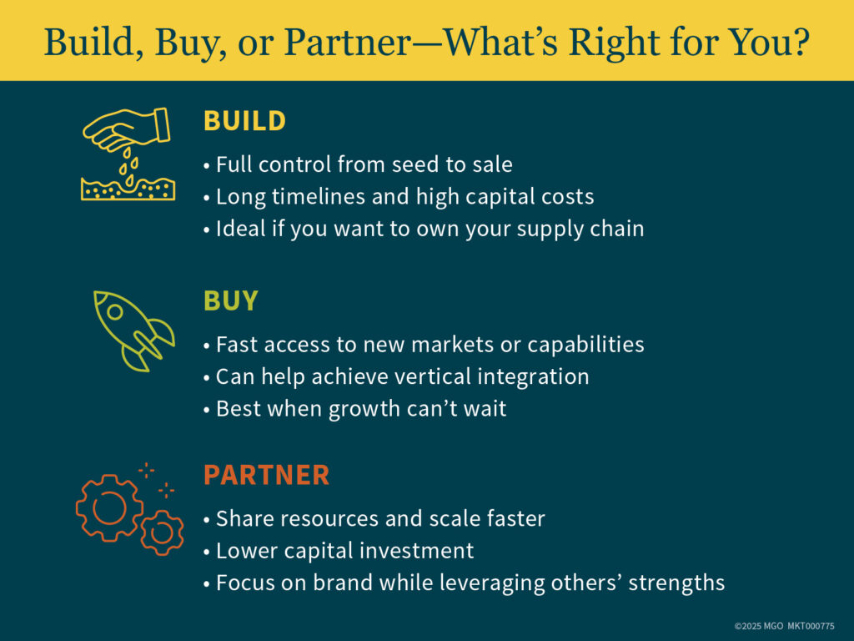- within Cannabis & Hemp topic(s)
- within Criminal Law, Strategy and Family and Matrimonial topic(s)
- with Finance and Tax Executives
- in United States
Key Takeaways:
- With the early rush for market presence behind us, today's M&A landscape is driven by strategy — whether that means developing in-house capabilities, acquiring complementary operations, or forming partnerships to scale.
- Building a vertical operation offers control but requires major capital investment. Buying or partnering can provide quicker access to new markets, product categories, or operational strengths.
- Most companies are blending approaches — building where they have strength, acquiring where they see opportunity, and partnering where agility or cost efficiency is key. The right mix depends on your goals, resources, and long-term vision.
As the cannabis industry continues to mature, the era of rapid expansion has passed. Today's deals are more strategic — often designed to strengthen your position in a key state, fill operational gaps, expand into new product categories, or accelerate growth through vertical integration. Whether you're aiming to deepen your capabilities or reach new markets, one key question remains: Should you build, buy, or partner?
Build: Owning the Supply Chain from Seed to Sale
If you're looking to control every part of your operation — from cultivation and manufacturing to distribution and retail — building a vertical model may be your goal. Multi-state operators (MSOs) like Green Thumb Industries and Trulieve, as well as many single-state operators (SSOs), have leaned into this approach. By developing capabilities in-house, they've been able to reduce reliance on third parties, improve margins, and exert more control over quality and branding.
But vertical integration isn't simple. Building requires significant capital investment, broadened regulatory compliance, and expanded management teams with the necessary skills, knowledge and experience. If you're considering this path, ask yourself: Do you have the time, capital, and team to make it work? If not, you may want to consider a faster route — buying or partnering.
Buy: Acquiring the Missing Pieces of Your Business
Buying is a powerful way to expand your reach or capabilities — especially when speed and scale matter. Acquisitions can help you enter a new market, acquire valuable IP, or achieve vertical integration. Companies like Tilray and Village Farms have used acquisitions to diversify their operations and enter new verticals.
If you're a retailer lacking cultivation, buying a grow operation might make strategic sense. But be aware: buying your way into vertical integration can also mean inheriting the very challenges — capital demands, regulatory complexity, operational risk — that come with building it from the ground up. You'll need to understand your financial limitations, build accurate valuation models, and ensure any acquisition aligns with your long-term strategy.
Start by defining what you're missing. Are you looking to own more of your supply chain? Break into a new product category? Cement your presence in a strategic state? Once those drivers are clear, begin identifying targets that align with your goals — and run the numbers to see if the deal will create the value you need.
Partner: Team Up to Accelerate Growth
If you don't have the bandwidth or resources to build or buy, strategic partnerships can fill the gap. Brands like Belushi's Farm, Death Row Cannabis, and Cann have leaned into licensing, co-packing, and distribution partnerships to scale without the burden of full operations.
Partnerships are also a powerful tool for entering new and complex markets. Take Oregon-based brand Alibi, for example. Rather than starting from scratch in New York, the company is cultivating its presence by partnering with licensed producers and retailers to bring its products to market. It's a flexible and capital-efficient way to gain traction in highly regulated states.
Partnering lets you tap into another company's strengths — whether it's their facilities or local market knowledge — while focusing on your brand and growth. It's often the fastest and most flexible route to expansion. But it still requires careful due diligence. Make sure any partnership aligns with your business model, protects your brand, and has clear financial and operational terms.

How to Choose the Best Option for You
Whether you're building vertically, acquiring brands, or forming partnerships, your growth moves should be guided by strategy — not just opportunity. With continued margin pressure, tightening capital markets, and increased competition, managing capital and maximizing return on your resources is essential.
Start with these three key questions:
- What are you trying to achieve? Is your goal to increase revenue, reduce overhead, enter a new market, or gain control over your supply chain?
- What's your financial reality? Can you realistically build or buy? Or would a low-capital partnership be more sustainable right now? Understanding your limitations early can save you from costly missteps later.
- What targets align with your capacity? Whether you're evaluating retail locations, beverage brands, or co-packing partners, a deal only makes sense if it supports your long-term goals — and you have the infrastructure to support it.
Your choice between building, buying, or partnering should reflect not just current market conditions, but your vision for where the industry — and your company — are headed.
The content of this article is intended to provide a general guide to the subject matter. Specialist advice should be sought about your specific circumstances.


